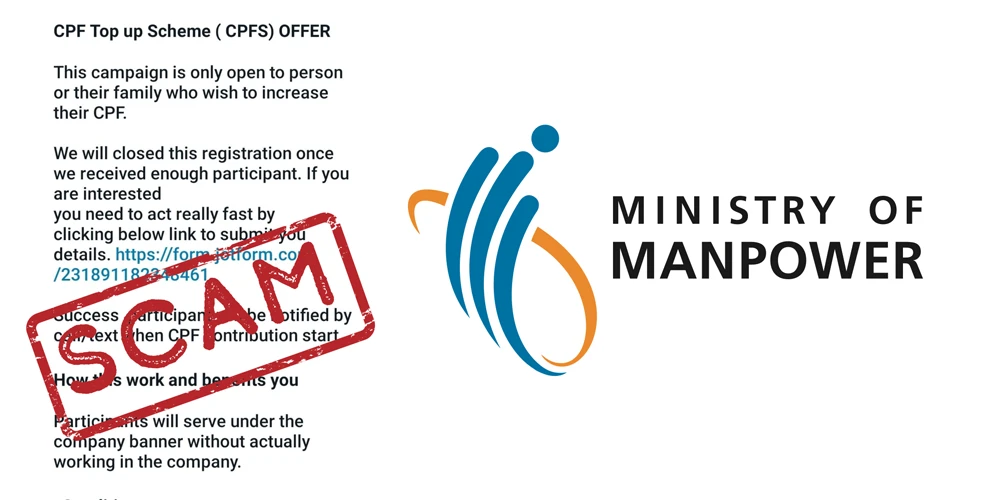The Ministry of Manpower (MOM) in Singapore has issued a warning about a WhatsApp scam called CPF Top up Scheme (CPFS). Scammers are claiming that individuals can receive additional Central Provident Fund (CPF) contributions by submitting personal information through a provided link.
MOM advises the public to be vigilant and not share these scam messages with others. If anyone has been targeted by the scam, they should immediately lodge a police report.
MOM has also emphasized the importance of staying alert and cautious, and encourages reporting any incidents of being targeted by the scam.
Table of Contents
What Is CPF Top up Scheme Scam?
Scammers claim that submitting personal information via the provided link will result in additional Central Provident Fund (CPF) contributions. This fraudulent scheme, known as the CPF Top up Scheme Scam, has had a significant impact on its victims.
Individuals who fall for this scam often find themselves at a financial loss and their personal information compromised. The scammers exploit the desire for belonging and financial security, preying on the vulnerability of unsuspecting individuals.
Once the victims provide their personal information, the scammers can gain access to their CPF accounts and potentially steal their hard-earned savings.
The impact of this scam is not only financial but also psychological, as victims may experience feelings of betrayal and distrust.
It is crucial for the public to remain vigilant and report any suspicious activity to prevent others from falling victim to this scam.
How Does the CPF Top up Scheme Scam Works?
Perpetrators of the CPF Top up Scheme scam lure victims with promises of additional contributions to their Central Provident Fund through a provided link. This scam preys on individuals’ desire to boost their retirement savings.
Common techniques used by scammers include sending messages through platforms like WhatsApp, claiming that submitting personal information via the provided link will result in increased CPF contributions.
To prevent CPF top up scheme scams, authorities such as the Ministry of Manpower (MOM) have taken steps to raise awareness and caution the public.
MOM has issued warnings about the scam, urging individuals to remain vigilant and not share the scam messages with others. They also encourage affected individuals to lodge a police report immediately.
Red Flags and Warning Signs
Authorities have highlighted several red flags and warning signs to help individuals identify and avoid falling victim to the CPF Top up Scheme scam. These include:
- Unverified sources: Be cautious of messages from unknown senders or suspicious sources claiming to offer CPF top-up schemes.
- Urgency and pressure tactics: Scammers often create a sense of urgency, pressuring individuals to act quickly without proper verification.
- Requests for personal information: Be wary of any messages asking for personal details such as NRIC number, bank account information, or passwords.
- Poor grammar and spelling errors: Scam messages often contain grammatical mistakes or spelling errors, indicating a lack of professionalism.
- Unusual URLs or suspicious links: Avoid clicking on links in messages that appear suspicious or lead to unfamiliar websites.
To protect yourself from falling victim to this scam, it is important to be vigilant and exercise caution when receiving messages related to CPF top-up schemes. If you suspect a scam, report the incident to the authorities immediately to prevent further harm.
Customer Reviews and Complaints
Customers have expressed their concerns and frustrations through various online platforms regarding the CPF Top up Scheme scam. This scam has had serious consequences for those who have fallen victim to it.
Here are some of the consequences and prevention measures related to the CPF Top up Scheme Scam:
- Loss of personal information: Scammers trick individuals into providing personal information, which can then be used for identity theft or other fraudulent activities.
- Financial loss: Victims may lose money through unauthorized transactions or by providing scammers with access to their bank accounts.
- Emotional distress: Being scammed can cause significant emotional distress, including feelings of betrayal and violation.
- Trust issues: Victims may find it difficult to trust others, making it harder for them to engage in financial transactions or seek help.
- Prevention measures: The Ministry of Manpower advises the public to stay vigilant, avoid sharing scam messages, and report any incidents to the authorities.
How to Protect Yourself From CPF Top up Scheme Scam?
To protect oneself from the CPF Top up Scheme scam, individuals should remain vigilant and refrain from sharing suspicious messages. The CPF Top up Scheme scam is a prevalent scam tactic used by scammers to deceive individuals into providing personal information with the promise of additional Central Provident Fund contributions.
If you have been scammed, here are some steps you can take:
- Immediately lodge a police report to report the incident.
- Contact your bank or financial institution to inform them of the scam and to prevent any unauthorized transactions.
- Monitor your accounts and statements closely for any suspicious activity.
- Educate yourself about common scam tactics to better protect yourself in the future.
Conclusion – CPF Top Up Scam
Individuals should remain cautious and informed about scams to protect themselves from falling victim.
In the case of the CPF top-up scheme scam, it is essential to know how to report incidents and be aware of common tactics used by scammers.
If you encounter such a scam, it is crucial to report it immediately to the authorities, such as the police. By doing so, you not only protect yourself but also help prevent others from becoming victims.
Scammers often employ tactics like claiming to offer additional CPF contributions in exchange for personal information. Being aware of these tactics can help you identify and avoid falling into their traps.
Remember to stay vigilant, share information about scams, and report any suspicious messages or activities to the relevant authorities.
Frequently Asked Questions
What Are the Common Methods Used by Scammers to Deceive Individuals in the CPF Top up Scheme Scam?
Common methods used by scammers in the CPF top up scheme scam include sending scam messages through platforms like WhatsApp and requesting personal information. To avoid falling victim, individuals should stay vigilant, not share scam messages, and report any suspicious activity to the authorities.
Are There Any Specific Red Flags or Warning Signs That Individuals Should Look Out for to Identify the CPF Top up Scheme Scam?
Warning signs to identify CPF top up scheme scam include receiving unsolicited messages offering additional CPF contributions, being asked to submit personal information through unknown links, and the promise of high returns. To avoid falling victim, individuals should exercise caution, verify the legitimacy of the offer, and report any suspicious messages to the authorities.
Have There Been Any Customer Reviews or Complaints Regarding the CPF Top up Scheme Scam?
Customer experiences with the CPF Top up Scheme scam have been reported, highlighting the need for scam prevention measures. Individuals should stay vigilant and report any suspicious messages or activities to the authorities to protect themselves and others.
What Steps Can Individuals Take to Protect Themselves From Falling Victim to the CPF Top up Scheme Scam?
Individuals can protect themselves from falling victim to the CPF Top up Scheme scam by taking steps such as reporting the scam to the authorities and educating others about the scam to prevent further spread.
In Conclusion, What Is the Overall Impact and Severity of the CPF Top up Scheme Scam in Singapore?
The CPF Top up Scheme scam in Singapore has had a significant overall impact and severity. Scammers use common methods like WhatsApp to deceive individuals. Red flags include requests for personal information. Customer reviews emphasize the importance of staying vigilant and following protection steps.
Also Read
Untups.com Scam Exposed – Don’t Fall for This USPS Impersonator
Twverify Scam: Uncovering Fraudulent Activities and Safety Tips
Duskweling Scam Women’s Clothing Store: Don’t Fall Victim!
Also Read
Duskweling.Com Scam – The Shocking Truth About Duskweling
Meddox Scam: Health Documentation App Scam Exposed!
Shanor & Franklin LLC Scam Uncovered- Don’t Be Fooled!
Also Read
Is Asweus Scam or Legit? Discover the Shocking Truth!
Robert Walters Recruitment Scam – Avoid Falling Victim!
Usps Revepost Scam Exposed – Don’t Be The Next Victim!
Also Read
Cath Kidston Sale Scam – Cathkidstonsale.Com Scam Exposed!
Cath Kidston Scam – Is Cathkidstonuk.com a Scam Website?
Is Taxrebates.co.uk Legit? Tax Rebates Limited Reviews
Also Read
Curvesoul Clothing Reviews – Is Curvesoul Clothing Legit?
Peninty Clothing Reviews: Is Peninty Clothing Legit or Scam?
Is Mywinningcode Scam or Legit? Discover the Shocking Truth!
Also Read
Is Summersale Co Scam or Legit? Don’t Fall Victim!
Maddox Scam – Unmasking the Maddox Capital Partners Clone Scam
Is Go Sunvalue Scam or Legit? Free Solar Panels Exposed!
Also Read



















































